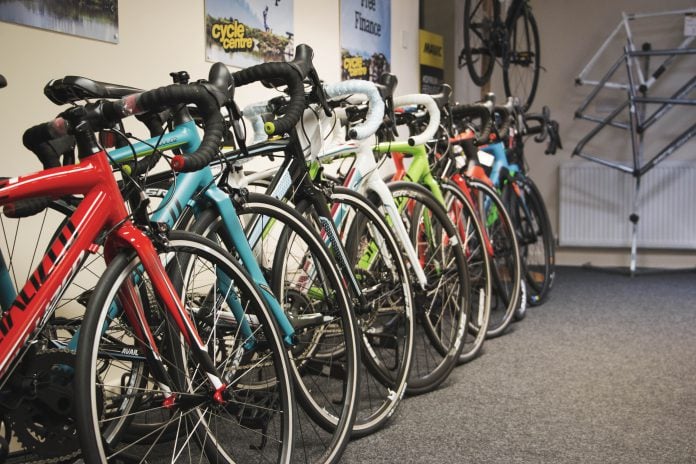Carbon, Aluminium, Steel & Titanium. Many different frame materials are thrown around from day to day with a huge amount of choice already in the frames shape, size and design. So what are the fundamental differences between the various frame materials, and which one is going to suit you best? Hopefully this article will be able to help you out in your selection.
It’s no great secret that all of the different materials come with their advantages and disadvantages. And a good frame design can help optimise this and play to the strengths of the material. And at CycleStore, we stock almost all of the options!

Show us what you’re made of.
With the exception of carbon all bike frames are alloys. This means that the properties of the metal have been adapted to get the best out of the material, for example steel is iron with carbon added. Almost the same as a cooking recipe, a whole variety of different ingredients can be added to get the desired effect.
— CYCLE OF GOOD – A NEW COLLABORATION —

The outright strength of a bike isn’t necessarily that important. But by improving the stiffness of the material it will help the bike frame to withstand the loads necessary for cycling. Toughness is a key quality to stop the bike getting damaged in an accident or by any knocks/bruises obtained out on the road or in transit. Tougher materials are likely to bend in the case of an accident, this is quite important as the last thing you want is a shard of bike in your leg if you have a crash.
Steel.
Steel is one of the most common alloys in society, appearing in all kinds of different appliances. Cheap to manufacture, stiff and strong, it’s also one of the most dense frame building materials. Often known for being very heavy, but very resistant to knocks. Frame builders can use smaller diameter tubes and thinner walls for the same strength/stiffness as some of the other materials.

Most cycling steel alloys are improved through heat treatment – alternately heating & cooling the steel in a specific way to improve properties. There are a variety of different alloys used through the cycling world and there’s no ‘best version’, this now includes the introduction of ultra-high strength (UHS) steel. This helped reduce the wall thickness in the steel tubes.
— ENDURA MTR WATERPROOF JACKET REVIEW —
Due to steel being made up of iron this means that it can rust. It can be treated to become stainless although if neglected it will become damaged over time. Stainless tubing can eliminate most of this problem.
Steel is one of the materials that you can really see any defects before they happen. It has a large threshold of deform before it will fail. It’s not like carbon where damage could be invisible, you’ll really be able to see bends in the steel before it fails on you completely. Although even when it does it can be possible to bend the frame back into place – thus repairing the frame.
Aluminium.
Aluminium is cheap, lightweight, corrosion resistant and easy to form into frames. It comes as no surprise that it’s one of the most popular materials used for bikes. It’s not got the same properties as steel in terms of strength and stiffness, it somewhat lacks in this department. But it comes at around one-third of the density, making it much lighter, in fact approximately one-third lighter too! This is why you see larger tubes on aluminium and the frame size is much larger in volume – to achieve the desired stiffness.
— THE VALUE OF CYCLING IN BRITAIN’S ECONOMY —

Over the years aluminium has gained quite an unfair reputation for providing a bit of a harsh ride. We think that aluminium frames can ride very nicely, in fact we’ve seen them keep up with a lot of carbon frames under the right rider.
This is probably due to the fact when they first came out they were built to the sizes of steel frames, which just didn’t work as the materials weren’t used in their proper ways. The weld areas can concentrate the stress through the bike and cause cracking, this is now smoothed out to avoid this. On the whole aluminium is more prone to damaging than steel, although they’re now designed to withstand all of the relevant loads, so there’s no compromised safety.
It’s often said that aluminium bikes don’t last as long as the other materials. Aluminium doesn’t have a fatigue limit like steel or titanium. This means that after a number of uses the composite would begin to fail, although in the world of bikes that number of uses would be incredibly impressive to achieve. They certainly don’t come with planned obsolescence (designed to fail). Under normal loading the frame of a well designed aluminium bike wouldn’t fail on you, as long as the stress is suitably distributed through the frame.
Titanium.
Swiftly coming back into fashion titanium frames are becoming more and more common. It’s slightly heavier than aluminium, although not up there with steel. Titanium fatigues a lot slower than steel or aluminium and can be exposed to a huge number of stresses before it will fail. It’s often said that a titanium frame can be a ‘frame for life’. With the right frame design titanium can be sculpted into very light frames without any chance of failure, although this comes at an elevated cost. It is often left unpainted mainly due to the fact that it doesn’t corrode in the same way steel does and comes with a very pleasing aesthetic.
Titanium itself is very easy to come by. Often used in aerospace design it takes a lot of work to forge the materials into bikes. This is part of the reason frame design comes at such a high cost, because the tools used wear fast and it takes a very controlled environment to get right. The stiffness of the material is somewhere in the middle of the bike making materials, making it an equally solid choice.
Carbon.
At the top end of the cycling range comes carbon. Often one of the first questions from the ignorant is “is your bike made of carbon?”. Renowned for being the best bike making material, it’s the newest of the current list, although it also comes with the highest price tag. Carbon’s strength to weight ratio is fantastic, and it’s incredibly stiff making it the perfect choice for a bike frame material.

The material is built by layering up sheets of carbon into a weaved or aligned pattern forming a laminate. This means that carbon is directional. The quality of this process is imperative as poor bonding can cause weakness in the material. The properties will vary depending on which way the load comes from, meaning that good design of the frame is imperative. It can be very weak and quite flexible in some of the directions.
The fibres of carbon behave very similarly to timber or rope, very strong in tension although would crumple under compression. Due to this a resin matrix is added to provide compressive strength before being cured to finalise the form.
Carbon can be designed to achieve very specific properties depending on the area of the bike it is used. A whole variety of builds can achieve different effects from a stern, race ready ride to a more comfortable bike. Stiffness and strength can be completely adapted from place to place. Areas can be reinforced to take larger loads such as forks, brackets or seat posts. Some parts can even come with improved crash resistance when other fibre types are used.
The biggest draw back with carbon frames is the brittleness of the material. Damage can’t always be seen as it doesn’t bend in the same way that the metals do and it’s said that carbon should be replaced after every bump. Assessments for damage of the frame can be quite hard and complicated. It can be known to snap or shear if it’s knocked too much. It fails very suddenly when the limit is reached and it’s very hard to repair carbon frames – which is why they’re very often written off.
That being said it is possible to repair carbon frames although a lot has to be learned about the original build. It’s often a specialist service offered by a third party as many bike manufacturers won’t get involved in repair but will offer crash replacements.
Which frame should you buy.
All of the materials have pros and cons as outlined above. It’s possible to make a good, suitable frame out of any of the materials. A talented bike builder would be able to use any of the above to find a material that really suits your style of riding. Obviously the price bracket of each material is going to be very different, however the end use of the bike is going to determine what you spend.
If you’re looking for a high performance, racing bike it’s most likely that you’ll settle for carbon fibre or aluminium. Carbon is hands down the best if you’re looking at the numbers, but will come with the biggest hit to your bank account. This makes aluminium a great middle ground.
But if you’re looking for a more resilient, comfortable commuter that may last you a few years, steel or titanium are much more likely to be considered. Becoming bikes more for the real collectors and lovers of the craft, there is a certain romance about the way these bikes are crafted and put together, who can say no to a beautifully hand crafted Italian frame.









